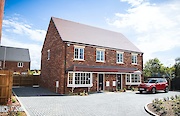


Head of Content

Mortgage Advisor & Director

Bad credit is an added complication if you are in the market for a buy-to-let (BTL) mortgage, but it isn’t always a deal breaker. Here you will learn whether you fit the criteria for a bad credit BTL, how to get one, and what we can do to help.
Can you get a buy-to-let mortgage if you have bad credit?
Yes. It is possible to get a buy-to-let mortgage with bad credit but whether you are approved will largely depend on the type of bad credit you have and how long you have had it for.
As a landlord, or an aspiring landlord, with adverse credit, you will pose a higher risk to mortgage lenders, but you can boost your chances of approval by putting down a higher deposit. You are also likely to have more options if you are an experienced landlord.
Expert advice is recommended if you are considered a buy-to-let investment with bad credit, and at Teito, there are brokers who specialise in this area.
Eligibility criteria
Landlords seeking a bad credit buy-to-let mortgage will need to meet the following criteria:
Credit history
The circumstances surrounding your bad credit will be heavily scrutinised. It is more difficult to get approved for an investment mortgage with severe credit problems against your name, such as a bankruptcy or repossession, compared to something minor, like missed payments.
How long these issues have been recorded on your files is also a factor, and you will become increasingly more creditworthy over time. Your options will increase after 2-3 years, and even the most severe credit issues will disappear from your record after 6-7 years.
Landlords with recent or severe credit issues will often be asked for a larger deposit.
Landlord experience
Having a strong track record in the property business and plenty of experience as a landlord will work in your favour and can help offset the risk posed by your poor credit.
That isn’t to say there are no mortgages for first-time landlords, but having bad credit in addition to no experience in the buy-to-let game might restrict your options.
Deposit requirements
The average amount of deposit you will be asked to put down is 25-30% of the property’s value, but some lenders will ask for more if your bad credit is recent or severe.
Rental income
The rate you generate from your buy-to-let property will need to cover the mortgage payments by at least 125%. For applicants with moderate-to-severe adverse credit, there will likely be more options available if the rental income covers the repayments by 145%.
Other factors
Other factors such as property type and the applicant’s age can increase the level of risk when applying for a buy-to-let mortgage with a history of bad credit.
Some properties, such as HMOs and multi-unit freehold blocks, are riskier in general, and you will find fewer willing lenders if you will be 75 or over during the mortgage term.
Buying through a limited company can also mean some lenders might be deterred by your adverse, but the good news is that our brokers handle complex applications where more than one risk factor is present all the time. Get in touch to find out what your options are.
How to get a buy-to-let mortgage with bad credit
On Teito, we provide everything you need to get started with your bad credit buy-to-let mortgage application. You can begin by comparing the latest rates from lenders across the market for free, or choose the option to speak to one of our buy-to-let brokers.
As buy-to-let mortgages can be complex where bad credit is involved, we recommend starting off with a free, no-obligation chat with our advisers, who specialise in this area. But if you prefer the DIY approach, feel free to source you own mortgage deal below:

Find a better buy-to-let mortgage on Teito
What interest rate to expect
Bad credit mortgages can, in general, come with rates that are between one and two percentage points higher than standard mortgages, and this is true of BTL.
You can increase your chances of landing a lower rate by doing the following:
- Putting down extra deposit: The lowest rates are available at around 60% LTV, which means putting down a deposit of 40% of the property value.
- Optimising your credit reports: Download them for free on Checkmyfile and flag up any inaccuracies or outdated information with the credit reference agencies. Quick fixes like this can improve your credit position and help you land a better deal.
- Speak to a mortgage broker: There are brokers at Teito who specialise in buy-to-let and they often have access to exclusive deals with lower interest rates.
- Consider a longer fix: The lowest rates available right now are currency attached to longer fixed-rate buy-to-let mortgages, though this can change at any time.
Available mortgage lenders
It is possible to get approved for a buy-to-let mortgage with a history of bad credit at high street lenders, depending on the severity and age of the credit issues, but specialist mortgage providers tend to offer a wider range of deals under these circumstances.
Examples of lenders who specialise in bad credit buy-to-let mortgages include:
- Accord Mortgages: Will lend if adverse is minor or for a small amount.
- Coventry Building Society: Will lend if adverse is minor or for a small amount.
- Together: Have options for landlords with more severe credit issues.
- Precise Mortgages: A range of mortgages for landlords with various types of adverse.
Although these are representative examples of lenders who offer bad credit buy-to-let mortgages, approaching them directly is not recommended. Many of them can only be accessed via a broker, and going direct would mean limiting yourself to one product range.
How much you mortgage will cost
The amount you will pay for a bad credit buy-to-let mortgage each month will depend on the interest rate you qualify for and the term length you choose. You can get a rough idea of how much they could be by using our mortgage repayment calculator below.
We have set the default interest rate to 5.5% and the repayment type to interest-only to reflect a typical buy-to-let mortgage, but these values can be manually changed.
In addition to your repayments, BTL mortgages can also come with the following fees:
- Product fees: Can range between nothing and 5-7% of the loan amount for a buy-to-let mortgage. Fee-free deals often come with higher interest rates, but the fee itself can sometimes be added to the mortgage, at the lender’s discretion.
- Valuation fee: Some lenders will expect you to foot the cost of having the property you’re buying valued, and this can set you back between £250-3,000. This cost is likely to be higher if you are buying a complex property type, such as an HMO.
- Legal fees: Can range from a few hundred to several thousand pounds. Landlords may be charged the higher amount if they are buying through a limited company.
- Stamp duty: Assuming you own a residential property as well, you will need to pay an additional 3% stamp duty surcharge on your buy-to-let. You can find out exactly how much your bill will be for this tax in our guide to BTL stamp duty.
- Admin costs: This includes the booking fee, telegraphic transfer fee and the account fee. All in all, admin costs for a mortgage application can cost around £1,000.
Why choose Teito for your buy-to-let mortgage?
On Teito, you can compare the latest buy-to-let mortgage deals for free and speak to a broker who specialises in landlords who have bad credit.
Here are just some of the reasons why people choose our service:
- You can access the latest BTL rates in seconds
- Our brokers specialise in bad credit mortgages
- We are 5-star rated on leading review websites
- You can secure an agreement in principle in minutes
Ready to compare the latest buy-to-let mortgage rates and take advantage of a free, no-obligation chat with a broker who specialises in bad credit? Get started here.
FAQs
Not all buy-to-let mortgage lenders take credit scores into account but some use credit reference agencies such as Experian to establish who to offer finance to. Experian rates your credit profile out of 999, and a score of around 700 is considered ‘good’.
However, there are other credit reference agencies who use a completely different scoring system, and also lenders who don’t use credit scoring at all. These lenders simply check your files for any adverse credit and will look at the circumstances surrounding it.
A lender who takes this approach might be a better alternative for someone with bad credit, as providers that use numerical scoring may overlook the context around your credit history.
Choosing an Adviser
Selecting a qualified and experienced mortgage adviser is of great importance. To choose a suitable adviser, evaluate their qualifications, experience, and reputation, and ensure they are regulated by the Financial Conduct Authority (FCA).
Read reviews from previous clients and make sure they provide a clear explanation of the products and services they offer, as well as the fees and charges associated with them.













































































































































